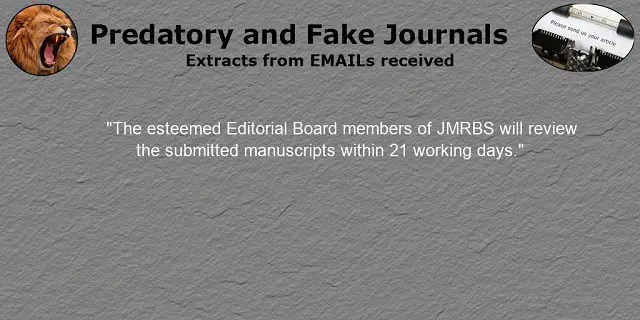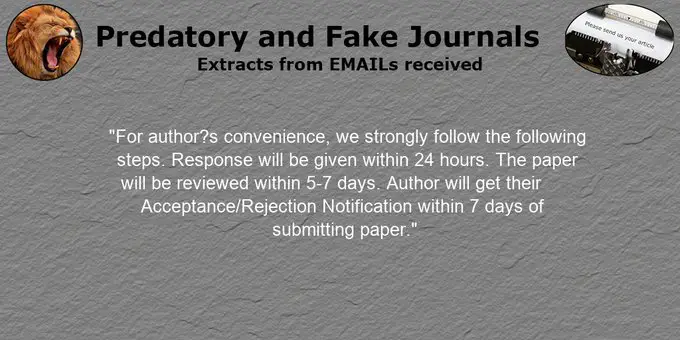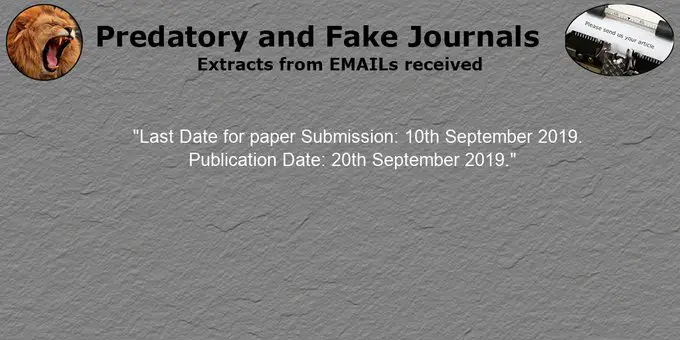Disclosure: This page may contain affiliate links. This means, at no additional cost to you, we receive a commission if you click through and make a purchase.
Predatory publishers accept papers without the usual levels of peer review that you would expect from a traditional publisher. In some cases, there is not even any peer review. The paper is just accepted.
Predatory publishers expect you to pay to publish the article, under the Open Access model of publishing. This model is an accepted way to publish scientific articles, but predatory publishers take advantage of this model, purely for monetary gains. If you are not familiar with the Open Access model of publishing there is plenty of help of the internet, as well as books such as “Open Access (MIT Press Essential Knowledge series)” by Peter Suber. A link to Amazon for this book is here.
There are many ways to identify a predatory publisher, but if you want to do a quick check you can look at the following three things.
- The journal promises very fast review times
- The journal promises very fast publication times
- Validate the editorial board
Any concerns about any one of these should be enough to make you ignore that journal.
Having this quick check list could save you a lot of time, and money, as any questions thrown up to any of these checks are likely to indicate that it is a journal from a predatory publisher and why take the risk where there are so many other journals to submit to?
We discuss these items in more detail below.
1. Very fast review times
When I publish a paper, in my own discipline, I expect to have to wait about six months for a review. Three months would be short, twelve months bordering on the unacceptable but between three and twelve months is okay.
I would not expect, and have never experienced, a review in a matter of days. That is not strictly true. I have had a couple of rejections within days. This is when a paper is rejected as the paper has been reviewed by the Editor-in-Chief and/or the Associate Editor and they have decided not to send it out for peer review. The usual reason for this is because the paper is out of scope for the journal.
The important point is that the paper is rejected in a matter of days. I have never had a paper accepted in a matter of days.
A predatory journal often promises very quick review times. The image above shows a snippet from an email that promises to review a paper within 21 working days. This seems unrealistic to us, at least from our own experience.
If you think that 21 days is reasonable, what about 5-7 days? The email snippet below promises to review the paper, and give a decision, within a week.
You might be interested in other emails that we archive, and report on our Twitter feed, using the hashtag #PredatoryPublishingEmails.
If you get an email inviting you to submit an article, which promises very short review times, I would simply ignore it. If you are tempted, carry out more due diligence by doing extra checks and seeking the advice of others.
2. Very fast publication times
When a paper is accepted, it can only take a few days for the paper to get a DOI (Digital Object Identifier). This gives the paper a permalink and means that the paper can be cited. But this is not the same as the paper being assigned to a volume/issue and having page numbers. There are some credible online journals that do away with these formalities but generally papers do still have a volume, issue and page numbers. In our view, this is a good thing (have volume, issue and page numbers, but that is very much a persoanl view).
In our experience, the time from when you have uploaded the camera-ready paper to it being published, complete with volume, issue and page numbers can take up to a year, or even more. This used to be a concern as you could not say the paper was published until that time. Now that DOI’s are commonplace it is not such an issue as the paper can be cited using the DOI.
If a journal is promising very fast publication times, it should raise alarm bells. The image above shows an EMAIL snippet that we have seen. This is not only promising publication in about 10 days but, I assume, also promising to review the paper in that time as well.
Like a journal promising very quick reviews, you should also treat with caution a journal which is promising quick publication times. We would strongly suggest that you simply ignore such a journal but if you do what to consider it, carry out further due diligence and take advice from your colleagues.
3. Validate the editorial board
One way of measuring the quality of a journal is the quality of its editorial board. The editorial board should be drawn from well-respected scholars from the relevant discipline and it is often desirable to have the members drawn from across the world so that the board represents the international community.
When you look at the editorial board for a journal there are some quick checks that you can do. You can certainly dive deeper, if you wish, but these quick checks might save you having to spend a lot of time researching the editorial board.

- Can you find the editorial board? If you struggle to find the editorial board on the journal’s web site, that should be cause for concern. It is usually easily accessible as the journal is rightly proud of the quality of the editorial board.
- Do the editors have pictures, URL or email addresses? If the editors do not have pictures or some way to contact them (via EMAIL or their home page) this should be cause for concern. I do not think this one is necessarily a deal breaker but this check, combined with the next suggestion, can raise a big red flag.
- Search for the editors: If the editors are not accessible directly from the editorial board page, then try and search for one or two, including the Editor-in-chief. Most scholars are easy to find on the Internet, especially if the search includes their institution.
- Is the editorial board international? A good measure of quality is how international the editorial board is. If the members are predominantly drawn from a single country this may not indicate that it is a predatory journal, but it does say something about the quality of the journal.
Final Thoughts
You should NOT submit to a predatory journal.
That goes without saying, but we state it anyway. If you think differently then we need to talk, as we are poles apart in our views!
The problem you face is identifying whether a journal is predatory. This can be time consuming but there are some quick checks that you can do and this article has given you three ideas. If the journal does not pass any of the above checks, then we would advise that you avoid that journal. Further checks might show that you were wrong, and it is not a predatory journal, but it is better to err on the side of caution and not to submit to a journal that is not predatory, rather than submitting to a journal and finding out later that it is predatory later.
We hope that the checks above will take only a few minutes and they will inform your decision with a high level of confidence. Those few minutes will be time well spent as you will not then contaminate your CV with articles in predatory journals.
You might also want to look at our article, which suggests ways to identify a NON-predatory journal or our article on how you can analyze a journal for signs that it might be predatory.





